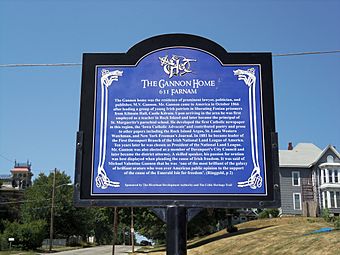M.V. Gannon House facts for kids
Quick facts for kids |
|
|
M.V. Gannon House
|
|

A sign placed by the Celtic Heritage Trail of the Quad Cities
|
|
| Location | 631 Farnam St. Davenport, Iowa |
|---|---|
| Area | less than one acre |
| Architectural style | Italianate |
| MPS | Davenport MRA |
| NRHP reference No. | 83002436 |
| Added to NRHP | July 7, 1983 |
The M.V. Gannon House was a special old home in Davenport, Iowa, United States. It was located on the east side of the city. This house was added to the National Register of Historic Places in 1983. This means it was recognized as an important historical site.
Contents
Who Was M.V. Gannon?
Michael Valentine Gannon was a very important person. He was a lawyer, a politician, and a publisher. He was born in Dublin, Ireland, on February 14, 1846. His father passed away when Michael was very young. He went to school in his local town. Before coming to the United States, Gannon helped a group of Irish patriots. They worked to free Irish prisoners from Kilmain Hall.
Gannon's Life in America
Gannon came to the United States in October 1866. He lived in New York City for almost a year. Later, he moved to what is now called the Quad Cities area. He first taught at a school in Rock Island, Illinois. Then, he became the principal of St. Marguerite's School in Davenport.
In the 1870s, Gannon started the first Catholic newspaper in the area. It was called the Iowa Catholic Advocate. He also wrote poems and stories for other newspapers. These included the Rock Island Argus and the New York Freeman’s Journal.
Gannon's Political Career
Gannon became a lawyer in 1872. He started his political career in the late 1870s. He was a member of the Democratic Party. He was elected as an alderman in Davenport. An alderman is a local official who helps run the city.
In 1881, he became a leader of the Irish National Land League of America. This group worked for Irish freedom. Gannon was elected as the local district attorney in 1882. A district attorney is a lawyer who represents the government in court. In 1884, he ran for Attorney General of Iowa but did not win. Gannon was known for his amazing speaking skills. He often spoke about the importance of Irish freedom.
Gannon's Family and Later Life
Gannon was married and had several children. He moved from Davenport to Omaha, Nebraska in 1887. Then, he moved to Chicago in 1902. He was a very active leader in the Irish community in both cities. In 1891, he was chosen as President of the Irish National Land League.
In 1905, Gannon returned to Davenport. He continued to speak out and support the Irish cause. He also went back to working as a lawyer. Gannon practiced law until three years before he passed away. After he retired, he visited his home country of Ireland one last time. He died in his home in Davenport on March 7, 1926.
What Did the House Look Like?
Gannon's house on Farnham Street was built in the Italianate style. This style was popular in the mid-1800s. He lived in this house before moving to Omaha. The house had a hipped roof. This means the roof sloped down on all four sides. It also had decorative brackets under the eaves. Eaves are the parts of the roof that hang over the walls. There was also fancy scrollwork on the front porch.
The front of the house once had three bays. A bay is a section of a building that sticks out. The main entrance was in the left bay. Over the years, the windows on the first and second floors were changed. Sadly, the house has since been torn down. Today, a sign from the Celtic Heritage Trail of the Quad Cities marks where the house used to stand.



